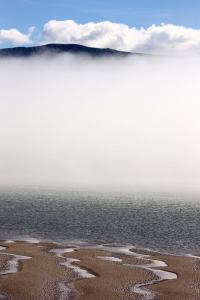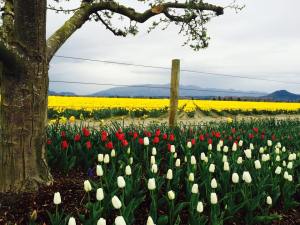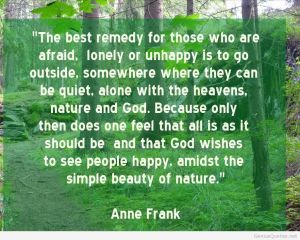
Borneo, Indonesia - tree of life
By Heila Rogers
Parietal? What is that again? “Parietal lobes” sound familiar? As in: the parts of the brain on the sides or walls of the skull.
Parietal art is therefore … on the sides of caves or walls. This kind of prehistoric cave painting – at least in a particular cave in France [Lascaux Caves] – means renditions of animals on the walls of deep tunnels stretching back underneath mountains. Inside exist amazing sketches and imprints made by blowing paint over a person’s hand placed against a wall. These works have survived for an incredibly long time. In these caves, unlike some other cave art throughout the world, there aren’t representations of people.
Research shows paleolithic man used scaffolding and artificial light to construct this art. Unlike some cave drawings in other parts of the world, none of these appear to be narrative … as in, no stories.
Why were these created?
Probably the purpose was religious. Many of them are not easily accessible, especially for a nomadic people. The works were probably completed by shamans only. Ancient people evidently practiced animal worship, and likely experienced spirits in the form of lions, buffalo or horses. The drawings might’ve been a kind of prayer. Requests for successful hunts. Or a part of vision rituals. The handprints include those of children, making some researchers think that the sick were taken into caves hoping perhaps to make a connection with the gods for healing.
A cave painting in Indonesia (shown above, thanks Wikipedia), entitled “Tree of Life,” pictures hands with a vine twining among them.
Without prior knowledge of the Dead Sea Scrolls or any Hebrew or Greek – way before the birth, death and resurrection of Jesus – this painting appears as if it could be a pictorial representation of the Bible verse: “I am the vine, you are the branches; he who abides in Me and I in him, he bears much fruit, for apart from Me you can do nothing.” (NASB John 15:5)
Many years before those words were written, this cave painting was established. The possible understanding(s) of such a concept by mankind waay B.C. or BCE is fascinating.
Or maybe it was the reverse. The concept and truth were there from the Beginning – at least a bit of it expressed in this very, very old painting and then in the words much later.
What is that truth?
What about, as expressed in these cave paintings, humankind’s desire to capture (have power over) or control … life, a situation, or a … creature?
Other questions:
Artists used bulges in the rock face to provide definition. How were these artists selected by the tribes? How did they display their talent? These so-called “survival societies” were pre-literate (but I imagine lots of verbal storytelling – they were still people after all) — and worked hard to get food and keep alive, so says the prevailing wisdom. There were issues of disease and accident. Where did God fit in? Is it true that they had less “leisure” time? Is art – the pursuit of creating or inventing visual things – a leisure-time, luxury pursuit? Or is it central to human nature and survival?
What about our disposition to go beyond ourselves for help?
It’s interesting to note that many of the caves were facing a certain way so as to be lit by the setting sun during the winter solstice.
What drives the human desire to worship? To go outside of ourselves to do so?
Where does the urge to create come from? No animals have it. They just live.
What about the desire to create pictures, a visual record? Why do we like to tell stories? Why do we want to, or feel a desire to attempt to control or manipulate the future? With “mystical rituals” we desire to capture the essence, or copy the creation of beings. What’s going on with that?
Prehistoric man looked around at the stars, the sun, experienced emotions, felt the love she or he had for others … and drew conclusions.
Another issue with this parietal art is that underground itself was perceived to be supernatural (apparently non-spirit-seeking spelunkers experience visions in deep caves – something biological about this). Caves alone, even without decoration, were seen as gates to the Beyond … indicating an awareness, a sense of eternity?
Dr. Jean Clottes has much of interest to say on the subject at: http://www.bradshawfoundation.com/clottes/page7.php
“Finally, hand stencils enabled them to go further still. When somebody put his or her hand on to the wall and paint was blown all over it, the hand would blend with the wall and take its new colour, be it red or black. Under the power of the sacred paint, the hand would metaphorically vanish into the wall. It would thus, concretely, link its owner to the world of the spirits. This might enable the ‘lay people’, maybe the sick, to benefit directly from the forces of the world beyond. Seen in that light, the presence of hands belonging to very young children, such as those in Gargas, stops being extraordinary (Clottes & Lewis-Williams 1998, 2001).
”
“The animals, individualised by means of precise details, seem to float on the walls; they are disconnected from reality, without any ground line, often without respect of the laws of gravity, in the absence of any framework or surroundings.”
This all reminds me of the following, about “eternity in the hearts of men:”
“He has made everything beautiful in its time. He has also set eternity in the hearts of men; yet they cannot fathom what God has done from beginning to end.” (NIV Ecclesiastes 3.11)















